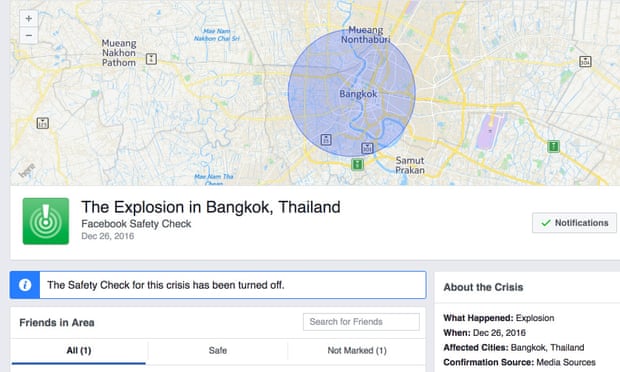
A Facebook safety check for Bangkok, which the company claimed was prompted by a one-man protest near the prime minister’s office, helped spread a fake news report of an explosion in the city.
The incident is the latest example of the social media platform’s algorithms failing to distinguish between reliable and faulty news sources.
Facebook’s safety check tool, which allows users to mark themselves safe in the event of a disaster or crisis, was activated in Bangkok on 26 December, citing “media sources” as confirmation of an explosion.
A Facebook spokesperson subsequently shared local media reports of a man protesting on a roof, throwing “ping pong bombs” or “giant firecrackers” in the direction of Government House, where the prime minister works. No one was injured, according to the Bangkok Post.
Facebook’s activation of the feature sowed confusion, however, because the platform also promoted a link to a false news report of a major “explosion”.
A screenshot of the feature shared by local journalist Saksith Saiyasombut shows that Facebook promoted a 26 December article by BangkokInformer.com in conjunction with the safety check.
That article consisted of a link to 17 August 2015 BBC video about the bombing of the Erawan Shrine, according to a copy of the article preserved by the Internet Archive.
The “source” of the @Facebook Safety Check for Bangkok: A fake news site that scrapped stuff from elsewhere…! pic.twitter.com/i6Q2k8XBxP
— Saksith Saiyasombut (@SaksithCNA) December 27, 2016
“No, there was not a massive explosion Bangkok on Tuesday night,” wrote local English-language newspaper Khaosod English in an article attempting to clarify the situation.
BangkokInformer.com is part of a network of local “news” websites that appear to simply repost articles from other sources. The company did not respond to a request for comment from the Guardian.
Facebook defended its activation of the safety check feature.
“As with all safety check activations, Facebook relies on a trusted third party to first confirm the incident and then on the community to use the tool and share with friends and family,” a spokesperson said in a statement.
When the safety check tool was launched in October 2014, it was only used for natural disasters. It was first used for a terrorist attack during the November 2015 Paris attacks. The company faced criticism, however, for its decision to activate the feature in some cases and not in others.
In November, the company announced that it would no longer directly control the feature, instead relying on alerts of incidents from a “third-party source”. The company’s explanation of the changes suggest that the feature is now controlled by algorithms detecting whether “people in the area are talking about the incident”.
The company declined to name its third-party source for incident reports.
Facebook has faced considerable criticism over its role in the dissemination of false information, especially following the US presidential election, in which news hoaxes and partisan propaganda ran rampant on the site.
On 15 December, the company announced that it would begin working with third-party fact checkers to flag viral fake news stories. Five fact-checking organizations are participating in a pilot program to combat fake news on the platform, but the pilot is limited by the staff capability of the independent organizations.
The pilot also requires the fact-checkers to address each false story individually – a challenge given that fake news stories can rapidly multiply across numerous websites.
The BangkokInformer.com article, for example, was subsequently copied onto msn.com, creating another misleading headline featured on the safety check tool.
Facebook spokeswoman Anna White pushed back against the idea that the tool was connected to the company’s fake news problem.
“Safety check the product is in no way connected with any news articles – real or fake,” White told the Guardian by email. “People seeing that [the BangkokInformer.com article] at the end of the product flow may have gotten odd information but that information did not trigger the activation in the first place like some outlets are reporting.”
The false BangkokInformer.com article remains the top search result for Facebook users searching for “Thailand explosion”. It has not been flagged as a fake news story by the independent fact checkers.
guardian.co.uk © Guardian News & Media Limited 2010
Published via the Guardian News Feed plugin for WordPress.
Facebook safety check helped spread false reports of Thailand explosionhttps://goo.gl/P4EX3W











0 comments:
Post a Comment